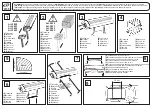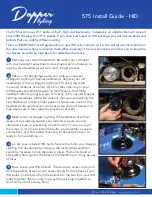
Advice
Wheels
Wheels and tyres
General notes
–
When driving with
new tyres
, be especially
careful during the first 500 km (300 miles).
–
If you have to drive over a kerb or similar
obstacle, drive very slowly and as near as
possible at a right angle to the obstacle.
–
Check from time to time if the tyres are
damaged (punctures, cuts, cracks or
dents). Remove any foreign objects embed-
ded in the treads.
–
Damaged wheels and tyres must be re-
placed immediately.
–
Keep grease, oil and fuel off the tyres.
–
Replace any missing valve caps as soon as
possible.
–
Mark the wheels before taking them off so
that they rotate in the same direction when
put back.
–
When removed, the wheels or tyres should
be stored in a cool, dry and preferably dark
place.
New tyres
New tyres do not give maximum
grip
straight
away and should therefore be “run in” by
driving carefully and at moderate speeds for
about the first 500 km (300 miles). This will
also increase the useful life of the tyres.
The
tread depth
of new tyres may vary, ac-
cording to the type and make of tyre and the
tread pattern.
Concealed damage
Damage to tyres and rims is often not readily
visible. If you notice unusual
vibration
or the
car
pulling to one side
, this may indicate that
one of the tyres is damaged. Reduce speed
immediately if there is any reason to suspect
that damage may have occurred. Inspect the
tyres for damage. If no external damage is
visible, drive slowly and carefully to the near-
est specialised workshop and have the car
inspected.
Tyres with directional tread pattern
An arrow on the tyre sidewall indicates the di-
rection of rotation on single drive tyres. Al-
ways note the direction of rotation indicated
when mounting the wheel. This guarantees
optimum grip and helps to avoid aquaplan-
ing, excessive noise and wear.
Retrofitting Accessories
If you wish to change or fit wheels, rims or
wheel trims, we recommend that you consult
with a SEAT Official Service centre for advice
regarding current techniques.
Useful life of tyres
Correct inflation pressures and sensible driv-
ing habits will increase the useful life of your
tyres.
–
Check tyre pressure at least once a month,
and also prior to any long trip.
–
The tyre pressure should only be checked
when the tyres are cold. Do not reduce the
pressure of warm tyres.
–
Adjust tyre pressure to the load being car-
ried by the vehicle.
–
In vehicles with a tyre pressure indicator,
save the pressure of modified tyres
.
–
Avoid fast cornering and hard acceleration.
–
Inspect the tyres for irregular wear from
time to time.
The useful life of your tyres depends on the
following factors:
Tyre pressure
Tyre pressure values are indicated on the
sticker on the inside of the fuel tank flap.
Insufficient or excessive pressure greatly re-
duces the useful life of the tyres and adverse-
ly affects vehicle performance and ride. Cor-
rect inflation pressures are very important,
especially at
high speeds
.
208
Summary of Contents for 2014 LEON CUP RACER
Page 1: ...OWNER S MANUAL Leon 5F0012720BC Inglés 5F0012720BC 11 14 GT9 Leon Inglés 11 14 ...
Page 4: ......
Page 8: ...The essentials Fig 2 6 ...
Page 10: ...The essentials Fig 4 Right hand drive 8 ...
Page 65: ......
Page 66: ...Operation Fig 81 Instruments and controls 64 ...
Page 281: ......
Page 282: ......
Page 284: ...OWNER S MANUAL Leon 5F0012720BC Inglés 5F0012720BC 11 14 GT9 Leon Inglés 11 14 ...
















































